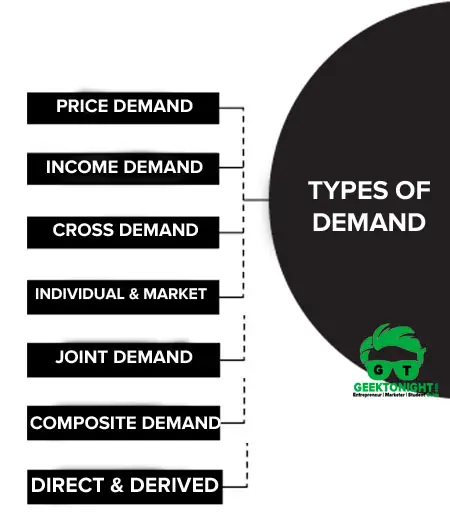Types of Demand: Price demand | Income demand | Cross demand | Individual and Market demand | Joint demand | Composite demand | Direct and Derived demand
What is Demand? Demand refers to the willingness or effective desire of individuals to buy a product supported by their purchasing power.
In economics, Demand is generally classified based on various factors, such as the number of consumers for a given product, the nature of products, the utility of products, and the interdependence of different demands.

Table of Content [Show]
Types of Demand
7 types of demand are:
- Price demand
- Income demand
- Cross demand
- Individual demand and Market demand
- Joint demand
- Composite demand
- Direct and Derived demand

Price demand
Price Demand is a demand for different quantities of a product or service that consumers intend to purchase at a given price and time period assuming other factors, such as prices of the related goods, level of income of consumers, and consumer preferences, remain unchanged.
Price demand is inversely proportional to the price of a product or service. As the price of a product or service rises, its demand falls and vice versa. Therefore, price demand indicates the functional relationship between the price of a product or service and the quantity demanded.
Price demand can be mathematically expressed as follows:
DA = f (PA) where,
DA = Demand for product A
f = Function
PA =Price of product A
Income demand
Income demand is a demand for different quantities of a commodity or service that consumers intend to purchase at different levels of income assuming other factors remain the same.
Generally, the demand for a commodity or service increases with an increase in the level of income of individuals except for inferior goods. Therefore, demand and income are directly proportional to normal goods whereas the demand and income are inversely proportional to inferior goods.
Relationship between demand and income can be mathematically expressed as follows:
DA = f (YA ), where,
DA = Demand for commodity A
f = Function
YA = Income of consumer A
Also Read: What is Business Economics?
Cross demand
Cross demand refers to the demand for different quantities of a commodity or service whose demand depends not only on its own price but also the price of other related commodities or services.
For example, tea and coffee are considered to be the substitutes of each other. Thus, when the price of coffee increases, people switch to tea. Consequently, the demand for tea increases. Thus, it can be said that tea and coffee have cross demand.
Mathematically, cross demand can be expressed as follows:
DA = f (PB), where,
DA = Demand for commodity A
f = Function
PB = Price of commodity B
Individual demand and Market demand
This is the classification of demand based on the number of consumers in the market. In dividual demand refers to the quantity of a commodity or service demanded by an individual consumer at a given price at a given time period.
For example, the quantity of sugar that an individual or household purchases in a month is the individual or household demand. The individual demand of a product is influenced by the price of a product, income of customers, and their tastes and preferences.
On the other hand, Market demand is the aggregate of individual demands of all the consumers of a product over a period of time at a specific price while other factors are constant.
For example, there are four consumers of sugar (having a certain price). These four consumers consume 30 kilograms, 40 kilograms, 50 kilograms, and 60 kilograms of sugar respectively in a month. Thus, the market demand for sugar is 180 kilograms in a month.
Joint demand
Joint demand is the quantity demanded for two or more commodities or services that are used jointly and are, thus demanded together.
For example, car and petrol, bread and butter, pen and refill, etc. are commodities that are used jointly and are demanded together. The demand for such commodities changes proportionately. For example, a rise in the demand for cars results in a proportionate rise in the demand for petrol.
However, in the case of joint demand, rise in the price of one commodity results in the fall of demand for the other commodity. In the above example, an increase in the price of cars will cause a fall in the demand of not only of cars but also of petrol.
Also Read: Law of Demand
Composite demand
Composite Demand is the demand for commodities or services that have multiple uses. For example, the demand for steel is a result of its use for various purposes like making utensils, car bodies, pipes, cans, etc.
In the case of a commodity or service having composite demand, a change in price results in a large change in the demand. This is because the demand for the commodity or service would change across its various usages.
In the above example, if the price of steel increases, the price of other products made of steel also increases. In such a case, people may restrict their consumption of products made of steel.
Direct and Derived demand
Direct demand is the demand for commodities or services meant for final consumption. This demand arises out of the natural desire of an individual to consume a particular product.
For example, the demand for food, shelter, clothes, and vehicles is direct demand as it arises out of the biological, physical, and other personal needs of consumers.
Derived demand refers to the demand for a product that arises due to the demand for other products. For example, the demand for cotton to produce cotton fabrics is derived demand.
Derived demand is applicable to manufacturers’ goods, such as raw materials, intermediate goods, or machines and equipment. Apart from this, the factors of production (land, labour, capital, and enterprise) also have a derived demand. For example, the demand for labour in the construction of buildings is a derived demand.
Leave a Reply